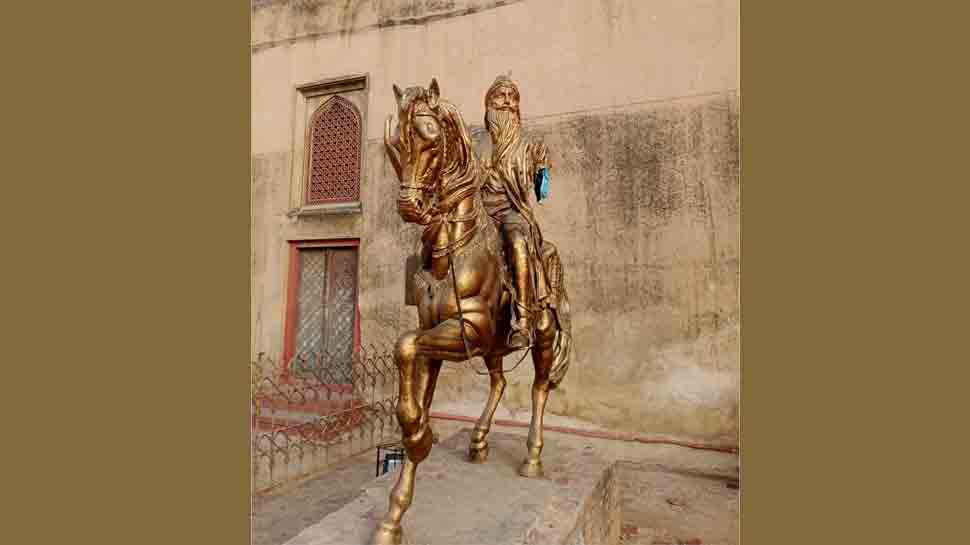A group of Islamic extremists in Pakistan vandalised the statue of Maharaja Ranjit Singh, erected at the Lahore Fort (Shahi Qila), at the Mai Jindan’s Haveli on December 12 (Saturday). The fort is an important historical monument for Sikhs and is located near Gurdwara Dera Sahib related to Guru Arjan Dev Ji.
The extremists entered inside the Qila with wooden rods, went straight to the statue, and started hitting it aggressively--breaking one of its arms and damaging other parts.
Few media reports published in popular Pakistani news platforms like The Dawn highlighted that the attackers claimed themselves to be the reincarnations of Mehmood Ghaznavi--an invader responsible for slaughtering thousands on non-Muslims in the Indian subcontinent.
The attackers also emphasized and reiterated that it was against their religion to construct a statue in a Muslim country and they shall keep continuing and repeating such acts of vandalism.
Zaheer, one of the culprits claimed that the statue of the Sikh ruler should not have been allowed to be erected in Pakistan at the first place due to ‘atrocities’ committed by him against Muslims during his rule. Even after making confession, Pakistani media is calling the act of vandalising the statue an ‘alleged’ act.
The extremists who damaged the statue were associated with and were radicalised by speeches of fundamentalist Pakistani preacher Maulana Khadim Hussain Rizvi-the founder of Tehreek-e-Labbaik. Maulana in his speeches accused Maharaja Ranjit Singh of murdering Muslims and used to urge Pakistanis to vandalise the statue.
It is not for the first time that the statue has been attacked. In August 2019, two attackers, identified as Adnan Mughal and Asad, damaged the statue after which it was kept covered for a long time. It would be interesting to see how long the statue of Sher-e-Punjab keeps standing amidst Pakistani radicals.
Besides, this is not the exclusive incident of attacking the symbols of the Sikh community as earlier this year, in January 2020, Pakistani radicals vandalized the holy Nankana Sahib Gurdwara and attacked the minority Sikh community there. An organised group of radicals also pelted stones at Sikh pilgrims visiting the Gurudwara. Stone pelters once again attacked the Gurudwara, recently in August 2020.
Further in August, the Augaf department of Pakistan, responsible for looking after religious matters, filled the walls of a18th-century Sikh Gurdwara located in Lahore with Islamic graffiti. The Gurdwara now also carries a Muslim title at the top of the main entrance, which reads -“mosque and madrasa Hazrat Shah Kaku Chishti.”
The Gurdwara is known as Sri Shahidi Asthan and is constructed over the land where Sikh warrior Bhai Taru Singh was slaughtered by radical Islamists. This has led to at least half a dozen clashes between local Sikh groups and madrasa students.
Earlier in May 2019, Pakistani Islamic extremists destroyed four centuries-old ‘Guru Nanak Palace’ on directions of government officials. The attackers took away and sold precious windows, doors, and even bricks of the monument. The old monument was built by intricately designed bricks and was painted with pictures of Guru Nanak Dev Ji and a number of Hindu rulers and princes.
Hatred of Pakistanis for Sikhs have seemingly transcended geographical boundaries. In May this year, a Pakistani national vandalised Guru Arjan Dev Gurdwara in Derby, UK. The individual was associated with a number of Pakistani groups in the UK. He also posted several anti- India messages over Kashmir before attacking the Gurdwara.
This is not only the case with radicals and political leaders, but Pakistani ‘intellectuals’ have also been making demands for removal of the statue for a long time. In a long article published on The Dawn, Pakistani historian Ali Usman Qasmi tried to prove why Pakistan needed to remove all the imprints of Maharaja Ranjit Singh from its soil. He also argued that his statue shall be removed to curb the Khalistani uprisings in Pakistan.
Regarding the statue, he wrote, "For me, the search for the ‘real’ Ranjit Singh is not important. I am more concerned about the legacy of Ranjit Singh as it is being created, invoked and commemorated.
He further commented, “Punjabi sense of nationhood has been sublimated within the larger Pakistani nationalism conflating Islam, Muslim and Urdu. This made it frustratingly hard for Punjabi intellectuals to plead for or articulate an idea of Punjabi nationhood that could be rooted in its language and mobilised for a progressive polity addressing class issues.”
The acts of insulting elements related to Sikh identities in Pakistan and the efforts to push anti-Maharaja Ranji Singh narrative has led to the intensification of the tussle between the Inter-Services Intelligence (ISI) and Pak-sponsored Khalistanis.
In a major development, sources suggest that a faction of Khalistanis are demanding ‘Greater Khalistan’ that includes Pakistani Punjab with Lahore as its capital. These groups are demanding Sikh groups to issue a new map of Khalistan and to begin a new movement to claim the region of Pakistani Punjab and Khyber Pakhtunkhwa as parts of Khalistan.
This shall indeed rewrite the dynamics between the ISI and Khalistani groups sponsored by it, leading to interesting developments in the coming time.
















